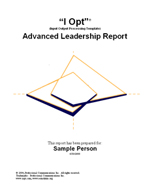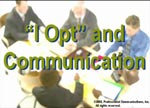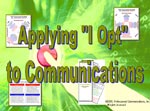Tools you can use.

Exercises/Programs
A major advantage of “I Opt” technology is that it can be used with existing programs and classes. It will not conflict with other valid instruments or existing programs.
The programs listed in this section have been reviewed by Professional Communications for consistency with "I Opt" and Organizational Engineering principles. PCI has not verified the efficiency, effectiveness or suitability for a particular purpose. The identified provider should be contacted directly to explore their use for the intended pupose.
Off-The-Shelf Programs
Scripted or "Off-the-Shelf" programs are fully specified, step-by-step instructional schemes. They can be used by internal and external trainers and consultants. They presume various levels of familiarity with "I Opt" technology. Some may require additional support material (e.g., various “I Opt” reports or supplemental products).
The cost of the program (if any) is identified where available. A general description of the program is also provided for orientational purposes only. Interested people should contact the identified provider for a complete description and full specification of the program or course.
TEAM DYNAMIC INSIGHTS - SELECTION

Teams can be "constructed." This exercise is intended to demonstrate that the composition of the team affects the mission of the group. Selection of team members will affect the character of the group and the likely group performance.
You will need 10 sample "I Opt" profiles in a transparency format. Divide the class into 5 to 8 person teams. Select a team mission that is not familiar to anyone participating in the exercise. For example, an 8 person team designed to raise money for an animal shelter, marketing a pharmaceutical drug, designing a water system for the city, etc.
Give your teams 15-30 minutes to select the profiles that they would include on the team and whom they would choose as the leader. Have each of your teams report back to the group discussing why they chose those particular people to include for the team and the leader. They might also discuss what advice they would give to their chosen leader on how best to manage the team.
Different mixes of people and leaders will operate in different but predictable ways in achieving their objective. The managerial task is to construct teams that can operate efficiently and effectively in a manner compatible with the larger organization of which they are a part.
TEAM DYNAMIC INSIGHTS - SUBSTITUTION

Team behavior can be changed by substituting individual people. This exercise shows that the substitution of a single individual can change the behavior of the entire group.
You will need transparencies for team. This can be a sample team you prepared in advance or a real existing team. If you are using a sample team, divide your class into 5 to 8 person groups. Have each group take 1 person out and discuss what the likely effect would be on group performance. If there is time, have them add a person and analyze the effect. Have each assessment group report back to the class on their evaluation (e.g., who had the most profound effect, etc.).
Variant:
When you select the assessment groups attempt to construct them into homogenous groups (e.g., dominant HA, LP, etc.). When the assessment groups report back you should see a perspective that reflects the dominant style of the assessment group. For example, HAs will tend to offer detailed, well-reasoned assessments; RSs will tend to focus on the effect on near-term performance, etc.The variant demonstrates that the evaluation depends on the perspective of the person doing the assessment as well as the objective qualities of those being assessed. This insight can be used to emphasize the value of consultation when arriving at judgments.
INTERPERSONAL ORIENTATION - "MATCHMAKING"

Contributed by Debbie Douglas of Lord Corporation
Make a copy of each class/team member's "I Opt" profile and blank out their names. Hang the profiles on the wall before the class/debriefing starts. This creates a level of interest and curiosity. Conduct a presentation orienting the class/team to the "I Opt" paradigm.
Give each class member a copy of the set of profiles. After the presentation have each class/team member write the name of the person they think the hanging graphs apply-including their own. After that is done, have them post the names to whom they think the graphs apply.
The name of the exercise creates instant interest and conversation. It connects "I Opt" to fundamental human processes. It is likely that there will be wide agreement on the names of people with pronounced profiles. This can be used to emphasize that "I Opt" is not psychological in nature. Their judgement was entirely behaviorally based.
There is likely to be a diversity of opinion on more balanced profiles. This can be used to point out that our interpretation of another person's behavior depends on two things. First, the behavior of the subject. Secondly, on the "I Opt" profile of the person doing the assessment. The "take home" is that people should be generous in their evaluation of others. Their judgment is being influenced by their strategic posture as well as that of the other person.
INTERPERSONAL ORIENTATION - "SPEED DATING"

Contributed by Debbie Douglas of Lord Corporation
This is a companion exercise to the "Matchmaking" exercise. The class/team members are given their actual "I Opt" profiles. A show of hands can be used to determine how many "guessed" their own profile correctly.
It is likely that a portion of the class would have guessed incorrectly. Point out that this is due to the fact that our own perceptions of ourselves are colored by those around us as well as by an objective assessment of our own behavior. For example, a person might think they are a strong RI idea generator. The profile might not show this. The judgment may be due to a lower RI strength among those with whom they associate.
The class/team members are then paired up on a rotational basis. Each pair discusses their actual profile versus the "guess" made by the other person. After 3-5 minutes, I have them switch partners and repeat until everyone has had an "I-Opt date" with their teammate.
The discussion process should make clear that everyone measures others using themselves as a standard. "Objective" reality is only objective in a local-not universal-sense. One of the values that an "I Opt" assessment provides is to give people a "touchstone" beyond their own personal experience.
Debbie Douglas reports that the naming of the exercises creates a great deal of interest and social conversation. This, in combination with the non-intrusive, behaviorally based character of "I Opt" causes the exercise to function as an "ice breaker" as well as an instructional tool.
LEADERSHIP EFFECTS - ADVANCED LEADER REPORT

The Advanced Leader Report offers a leadership assessment based on a "typical" group being lead. Actual groups may differ from this typical configuration. This exercise highlights these particular effects.
Students should have had access to and reviewed their Advanced Leader Report prior to this exercise. Provide each person with a set of 5 distinct profiles and designate them as the leader of the group.
Have each person provide an assessment of their likely effect on the group. Ask them to identify the methods they might use to motivate the group, how they might structure assignments (e.g., broken down into segments or in a mission level form). Have them use the "vulnerabilities" page of the Advanced Leader to identify their most pronounced exposure, etc.
Variant:
Use the same 5 person sample profiles for each person in the group. You are likely to see different aspects of leadership being highlighted by different people. You can use this to demonstrate the "art" of leadership. It is the application of "book learning" that distinguishes great leaders from good ones.Cartoons

The cartoons used on the "I Opt" home page are humerous but all illustrate real conditions that people using different "I Opt" styles typically confront.
These cartoons can be usefully incorporated into many types of programs and debriefing orientations. A package of all of the cartoons in .swf (i.e., Flash) fromat is available free of charge on request of Certified Organizational Engineers.
EMOTIONAL IMPACT TRAINING PROGRAM

The program is designed to help people control the emotional impact that they have on others. It is a narrated 66-slide PowerPoint training program that uses the "I Opt" Emotional Impact Management Report as its basis. It is available free of charge to Certified Organizational Engineers.
The "I Opt" Emotional Impact Management Program is designed to be flexible in terms of timing. There are optional sides, optional scripts/script segments and optional exercises. The program can be tailored to meet your exact needs. There is a separate PowerPoint that gives the timing of each slide with the optional elements clearly identified

The narration is on the "Notes" section. It is a full script and can be used in that form if desired. The instructor can pause wherever they choose and engage in class discussion. Alternatively, the narration can be used as an outline for the instructor to develop their own script. A full written script is also available upon request.
The program is too large to download via email and will be furnished through a dedicated download site.
CREATING A RESUME USING THE CAREER REPORT

This is a standalone video and is available on this website or in a Microsoft .wmv (native to Windows) format. The video shows how the "I Opt" Career Report can be used to construct a compelling resume.
While the video can be used as a standalone tool, Certified Organizational Engineers can get copies of the .jpeg images used in the video free of charge. These can then be incorporated into presentations and/or tailored programs of your own design.
"I OPT" AND COMMUNICATIONS

This is a two-video course on how "I Opt" applies to communication. The first video explains the communication process in detail. It stresses that effective communication involves the sender transmitting the message in a format that the receiver can accurately interpret.
The second video shows how the above knowledge can be used in applied situations. Various tools that can be used to improve communication are outlined. Most support tools are available free from the iopt.com website.
These videos are intended to act as a base for a communications course, not the course itself. Copies of the jpg images used are available free of charge to Certified Organization Engineers.

The applied video offers an option of using a card deck as a diagnostic and planning tool. The card deck can be constructed locally using card stock and any printer. Formatted free templates of the card deck can be downloaded HERE.